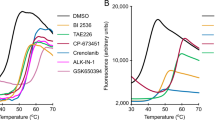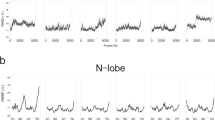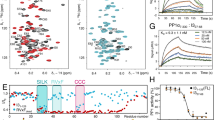Abstract
Here we show that, as a consequence of binding the drug trifluoperazine, a major conformational movement occurs in Ca2+-calmodulin (CaM). The tertiary structure changes from an elongated dumb-bell, with exposed hydrophobic surfaces, to a compact globular form which can no longer interact with its target enzymes. It is likely that inactivation of Ca2+-CaM by trifluoperazine is due to this major tertiary-structural alteration in Ca2+-CaM, which is initiated and stabilized by drug binding. This conformational change is similar to that which occurs on the binding of Ca2+-CaM to target peptides. Two hydrophobic binding pockets, created by amino acid residues adjacent to Ca2+-coordinating residues, form the key recognition sites on Ca2+-CaM for both inhibitors and target enzymes.
This is a preview of subscription content, access via your institution
Access options
Subscribe to this journal
Receive 12 print issues and online access
$189.00 per year
only $15.75 per issue
Buy this article
- Purchase on Springer Link
- Instant access to full article PDF
Prices may be subject to local taxes which are calculated during checkout
Similar content being viewed by others
References
Cheung, W.Y. Biological functions of calmodulin. Harvey Lect. 79, 173–216 (1985).
Bachs, O., Agell, N. & Carafoli, E. Calcium and calmodulin function in the nucleus. Biochim. biophys. Acta 1113, 259–270 (1992).
Lu, K.P. & Means, A.R. Regulation of the cell cycle by calcium and calmodulin. Endocrine Rev. 14, 40–58 (1993).
Rasmussen, C.D., Lu, K.P., Means, R.L. & Means, A.R. Calmodulin and cell cycle control. J. Physiol. 86, 83–88 (1992).
Hickie, R.A., Graham, M.J., Buckmeier, J.A. & Meyskens, F.L., Jr., Comparison of calmodulin gene expression in human neonatal melanocytes and metastatic melanoma cell lines. J. invest. Dermatol. 99, 764–773 (1992).
Nojima, H. Structural organization of multiple rat calmodulin genes. J molec. Biol. 208, 269–282 (1989).
Hickie, R.A., Wei, J.-W., Blyth, L.M. & Wong, D.Y.W. Cations and calmodulin in normal and neoplastic cell growth regulation. Can. J. Biochem. Cell. Biol. 61, 934–941 (1983).
Wei, J.-W. & Hickie, R.A. Increased content of calmodulin in Morris hepatoma 5123 t.c. (h). Biochem. biophys. Res. Comm. 100, 1562–1568 (1981).
Wei, J.-W., Morris, H.P. & Hickie, R.A. Positive correlation between calmodulin content and hepatoma growth rates. Cancer Res. 42, 2571–2574 (1982).
Ford, J.M. & Hait, W.N. Pharmacology of drugs that alter multidrug resistance in cancer. Pharmacol. Rev. 42, 155–199 (1990).
Hait, W.N. & Lazo, J.S. Calmodulin: a potential target for cancer chemotherapeutic agents. J. clin. Oncol. 4, 994–1012 (1986).
Hickie, R.A. et al. Anticalmodulin agents as inhibitors of human tumor cell clonogenicity. in: Human Tumor Cloning, (eds S. E. Salmon & J. M. Trent). 409–424 (Grune and Stratton, New York, N. Y.; (1984).
Miller, R.L. et al. Clinical modulation of doxorubicin resistance by the calmodulin-inhibitor, trifluoperazine: a Phase I/II trial. J. clin. Oncol. 6, 880–888 (1988).
Veigl, M.L., Klevit, R.E. & Sedwick, W.D. The uses and limitations of calmodulin antagonists. Pharmac. Ther. 44, 181–239 (1989).
Wei, J.-W., Hickie, R. A. & Klaassen, D. J. Inhibition of human breast cancer colony formation by anticalmodulin agents: trifluoperazine, W-7, and W-13. Cancer Chemother. Pharmacol. 11, 86–90 (1983).
Babu, Y.S., Bugg, C.E. & Cook, W.J. Structure of calmodulin refined at 2.2 Å resolution. J. molec. Biol. 203. 191–204 (1988).
Kretsinger, R.H. & Nockolds, C.E. Carp muscle calcium-binding protein II. Structure determination and general description. J. biol. Chem. 248, 3313–3326 (1973).
Gariépy, J. & Hodges, R. S. Primary sequence analysis and folding behavior of EF hands in relation to the mechanism of action of troponin C and calmodulin. FEBS Lett. 160, 1–6 (1983).
Bayley, P.M. & Martin, S.R. The α-helical content of calmodulin is increased by solution conditions favouring protein crystallisation. Biochim. biophys. Acta 1160, 16–21 (1992).
Meador, W.E., Means, A.R. & Quiocho, F.A. Target enzyme recognition by calmodulin: 2.4 Å structure of a calmodulin-peptide complex. Science 257, 1251–1255 (1992).
Meador, W.E., Means, A.R. & Quiocho, F.A. Modulation of calmodulin plasticity in molecular recognition on the basis of X-ray structures. Science 262, 1718–1721 (1993).
Ikura, M. et al. Solution structure of a calmodulin-target peptide complex by multidimensional NMR. Science 256, 632–638 (1992).
Roufogalis, B.D., Minochehomjee, A.-E.-V.M., & Al-Jobore, A. Pharmacological antagonism of calmodulin. Can. J. Biochem. Cell Biol., 61, 927–933 (1982).
Weiss, B., Sellinger-Barnette, M., Winkler, J.D. & Schechter, L.E. Calmodulin antagonists: structure-activity relationships. in: Calmodulin Antagonists and Cellular Biology, (eds H. Hidaka & D. J. Hartshorne) 45–62 (Academic, Orlando, FL.;1985).
Levin, R.M. & Weiss, B. Binding of trifluoperazine to the calcium-dependent activator of cyclic nucleotide phosphodiesterase. Molec. Pharmacol., 13, 690–697 (1977).
Massom, L., Lee, H. & Jarrett, H. W. Trifluoperazine binding to porcine brain calmodulin and skeletal muscle troponin C. Biochemistry 29, 671–681 (1990).
Jackson, A.E. & Puett, D. Binding of trifluoperazine and fluorene-containing compounds to calmodulin and adducts. Biochem. Pharmacol. 35, 4395–4400 (1986).
Klevit, R.E., Levine, B.A. & Williams, R.J.P. A study of calmodulin and its interaction with trifluoperazine by high resolution 1H NMR spectroscopy. FEBS Letts 123, 25–29 (1981).
Dalgarno, D.C. et al. The nature of the trifluoperazine binding sites on calmodulin and troponin-C. Biochim. biophys. Acta 791, 164–172 (1984).
Krebs, J. & Carafoli, E. Influence of Ca2+ and trifluoperazine on the structure of calmodulin A 1H-nuclear magnetic resonance study. Eur. J. Biochem. 124, 619–627 (1982).
Gehrig, L.M.B., Delbaere, L.T.J. & Hickie, R.A. Preliminary X-ray dataforthe calmodulin/trifluoperazine complex. J. molec. Biol. 177, 559–561 (1984).
Kawasaki, H. et al. Crystallization of calcium-calmodulin-trifluoperazine complex and an attempt at crystallizing calcium-free calmodulin. J. Biochem. 97, 1815–1818 (1985).
Ramakrishnan, C. & Ramachandran, G.N. Stereochemical criteria for polypeptide and protein chain conformations II Allowed conformations for a pair of peptide units. Biophys. J. 5, 909–933 (1965).
Marshak, D. R., Lukas, T. J. & Watterson, D. M. Drug-protein interactions: Binding of chlorpromazine to calmodulin, calmodulin fragments, and related calcium binding proteins. Biochemistry 24, 144–150 (1985).
Reid, R. E. Drug interaction with calmodulin: the binding site. J. theor. Biol. 105, 63–76 (1983).
Gariépy, J. & Hodges, R. S. Localization of a trifluoperazine binding site on troponin C. Biochemistry 22, 1586–1594 (1983).
Massom, L.R., Lukas, T.J., Persechini, A., Kretsinger, R.H., Watterson, D.M. & Jarrett, H.W. Biochemistry 30, 663–667 (1991).
Faust, F.M., Slisz, M. & Jarrett, H.W. Calmodulin is labeled at lysine 148 by a chemically reactive phenothiazine. J. biol. Chem. 262, 1938–1941 (1987).
Strynadka, N.C.J. & James, M.N.G. Two trifluoperazine-binding sites on calmodulin predicted from comparative molecular modeling with troponin-C. Prots Struc. Funct. Genet. 3, 1–17 (1988).
French, S. & Wilson, K.S. On the treatment of negative intensity observations. Acta crystallogr. A34, 517–525 (1978).
Andersson, A., Forsén, S., Thulin, E. & Vogel, H.J. Cadmium-113 nuclear maghetic resonance studies of proteolytic fragments of calmodulin: assignment of strong and weak cation binding sites. Biochemistry 22, 2309–2313 (1983).
CCP4. The SERC (U. K.) Collaborative Computing Project No. 4: A suite of programs for protein crystallography, (Daresbury Laboratory, Warrington, U. K.; 1979).
Roussel, A. & Cambillau, C. TURBO FRODO.in Silicon Graphics Geometry Partner Directory 77–78, (Silicon Graphics, Mountain View, CA; (1989).
Brünger, A. T., Kuriyan, J. & Karplus, M. Crystallographic R factor refinement by molecular dynamics. Science 235, 458–460 (1987).
McDowell, J.J.H. Trifluoperazine hydrochloride, a phenothiazine derivative. Acta crystallogr. B36, 2178–2181 (1980).
Bernstein, F.C. et al. The Protein Data Bank: a computer-based archival file for macromolecular structures. J. molec. Biol. 112, 535–542 (1977).
Author information
Authors and Affiliations
Rights and permissions
About this article
Cite this article
Vandonselaar, M., Hickie, R., Quail, W. et al. Trifluoperazine-induced conformational change in Ca2+-calmodulin. Nat Struct Mol Biol 1, 795–801 (1994). https://doi.org/10.1038/nsb1194-795
Received:
Accepted:
Issue Date:
DOI: https://doi.org/10.1038/nsb1194-795
This article is cited by
-
SGLT2 inhibitors prevent LPS-induced M1 macrophage polarization and alleviate inflammatory bowel disease by downregulating NHE1 expression
Inflammation Research (2023)
-
Antipsychotic phenothiazine drugs bind to KRAS in vitro
Journal of Biomolecular NMR (2021)
-
Repositioning of the antipsychotic drug TFP for sepsis treatment
Journal of Molecular Medicine (2019)
-
S100 proteins as therapeutic targets
Biophysical Reviews (2018)
-
RNA-seq of life stages of the oomycete Phytophthora infestans reveals dynamic changes in metabolic, signal transduction, and pathogenesis genes and a major role for calcium signaling in development
BMC Genomics (2017)



